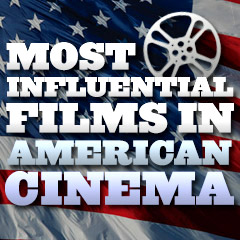Most Influential, Significant
and Important Films in American Cinema
(chronological by time period and film title)
|
|
Title Screen
|
Film Title/Year/Director/Length/Studio,
Descriptions of Influence/Significance |
Poster
|
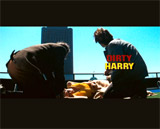
|
Dirty Harry (1971)
d. Don Siegel, 102 minutes, Warner Bros./Malpaso Company
- Director Don Siegel's controversial yet seminal
vigilante film of the decade joined other gritty revenge films including The
French Connection (1971), the UK's Get Carter (1971),
Death Wish (1974) featuring Charles Bronson, Walking Tall
(1973), The Seven-Ups (1973), and the Australian film Mad
Max (1979) with Mel Gibson.
- This was
the first of many hard-hitting, action-packed sequels (from 1973
to 1988) starring maverick, renegade vigilante cop Inspector "Dirty" Harry
Callahan ("Inspector 71") who was famous for sarcastic
one-liners, portrayed by steely-eyed Clint Eastwood in a career-boosting
role. The film reflected a pervasive fear of crime during the early
1970s.
- The main protagonist followed
his own unconventional philosophy of justice using "excessive
force," ruthless methods, and "the end justifies the means" principle
without much regard for the rules and legal regulations of his profession.
Often, his methods were as vicious, taunting, sadistic and violent
as the behavior of the criminals he opposed.
- Countless other cop-action films, many vigilante
films with anti-heroes who followed their own rules, were made
to copy this original law-and-order film that was one of the first
to appear on movie screens.
- The police thriller spawned many debates about the
political stance of the film and the complex issue of the conflicting
rights of victims, suspects, and society. Was it a reactionary
message piece against imperfect,
"liberal" judicial trends that let 'sicko' criminals get away,
literally, with murder? Or was Siegel encouraging audiences to empathically
identify with the indiscriminate vengeance of the violent, anarchic, unrestrained
vigilante 'killer' on the side of the law who acts as an autonomous police
power?
|
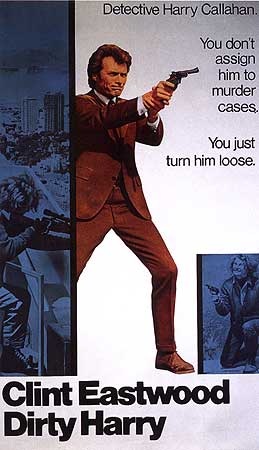
|

|
Sweet Sweetback's Baad Asssss
Song! (1971) (aka Sweet Sweetback)
d. Melvin Van Peebles, 97 minutes, Yeah/Cinemation Industries
- The blaxploitation film genre, with anti-Hollywood
films aimed at a primarily African-American audience, was launched
with Melvin Van Peebles' groundbreaking film -- it was the first
commercially-successful black-themed film. It
was the top-grossing independent movie of 1972.
- This unconventional, revolutionary, and seminal
blaxploitation film from the early 70s with an all-black cast was
directed, co-produced, edited, scored, and written by African-American
independent film-maker Melvin Van Peebles (his film debut) - he
also starred as the macho black hustler title character.
- After he refused to submit the film to the ratings
board (the MPAA), Peebles rated his own film with an X-rating -
and used this to his marketing advantage in its tagline
advertising on posters: "Rated
X By An All-White Jury!"
- The documentary-style, cheaply-made independent
film (budgeted at $150,000), aimed at urban black audiences, was
released by independent distributor Cinemation, and was shot on
location in about three weeks. It was an anti-White, anti-authority
diatribe. It was supplemented with jump-cuts, experimental lighting,
split-screens, freeze-frames, zoom-ins, tinted and overlapping
images and montages as it chronicled the successful (uncharacteristically)
flight of a black fugitive nicknamed "Sweet Sweetback" (due
to his large-sized manhood and insatiable sexual prowess) through
Los Angeles - and toward and across the Mexican border.
- The Hollywood establishment refused to financially
back this gritty, low-budget, sex-filled, realistic film with never-before-seen
images, soft-core sex and inflammatory racial politics, so Peebles
self-financed it (with $70,000 of his own money) and sought monetary
backing from Bill Cosby ($50,000). It was the first highly profitable
independent film made by a black filmmaker. It caused tremendous
controversy for its militancy, under-age sex, anti-white sentiment,
revenge-themes, and violence, although it was one of the most important
black American films of the decade. It was exceptional that a vengeful
black man (after witnessing corrupt police violence and almost
beating two officers to death) could survive as a fugitive, as
happened in the film.
- It forced Hollywood to acknowledge
the monetary potential of the untapped, urban African-American market
(similar to the effect Easy
Rider (1969) had on its countercultural audiences) as a
result of this influential film.
- In the same year, the important landmark crime/action
blaxploitation film Shaft (1971), starring Richard Roundtree
as a defiantly-proud black hero-detective, was directed by Gordon
Parks and would become a major cross-over hit. Variations included
female blaxploitation pictures, such as Cleopatra Jones (1973),
Coffy (1973) and Foxy
Brown (1974), with stars Tamara Dobson and Pam Grier.
From then on through the end of the decade (but mostly in the first
half of the decade), over 200 films would be released by major
and independent studios which featured major black characters (and
some black athletes such as Jim Brown and Rosie Grier), to profit
from the black movie-going audiences.
|
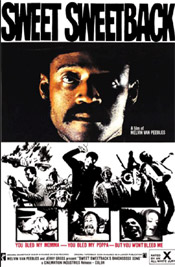
|
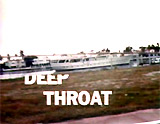
|
Deep Throat (1972)
d. Gerard Damiano, 61/50 minutes, Gerard Damiano Film Productions (GDFP)
- Unintended for mainstream audiences, this notorious
X-rated porn flick from writer/director Gerard Damiano became one
of the decade's top-grossing films, and one of the most influential
and successful (and profitable) of all films of its kind. Deep
Throat was
filmed in 6 days for $25,000 (some sources reported $50,000) and
was subsequently banned in 23 US states.
- It was an 'event' film - a hard-core stag film that
was OK to see on a date or in mixed company, yet it was banned
in many localities as obscene. It inaugurated
a period known as "Porno
Chic" -
it was the first cross-over adults-only film that became a hit. After
its initial period of release (at a time of sexual revolution), it
became a cultural phenomenon and it was fashionable to talk about
the film (and its educationally feminist theme of female sexual gratification)
or make references to it (such as Watergate's 'Deep Throat').
- It
brought adult movies into the popular culture - an era dubbed "The
Golden Age of Porn." The XXX-rated film demonstrated how a
once-vilified porn industry could produce a must-see film. Other
pornographic films that fared well and became popular included
Jim and Artie Mitchell's
Behind the Green Door (1972) with Marilyn Chambers, and
Gerard Damiano's The
Devil in Miss Jones (1973) with Georgina Spelvin, as well as
director Just Jaeckin's Emmanuelle (1974, Fr.). John Schlesinger's
bold X-rated Midnight
Cowboy (1969),
later re-rated as R, helped paved the way as the first (and only)
X-rated film to win the Academy Award for Best Picture.
- This hour-long, revolutionary X-rated film (shot
in about a week's time, with graphic enactments of oral, vaginal
and anal sex, group sex, and masturbation in a dozen and a half
sex scenes) told a simplistic plot (with some comic elements) about
a sexually frustrated woman (Linda Lovelace, born Linda Susan Boreman)
who wanted to "hear
bells" during sex. The film helped to educate adult audiences
to a wide range of sex acts other than standard
intercourse.
|
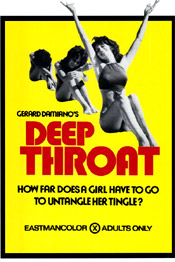
|
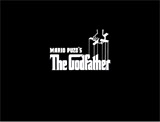
|
The Godfather (1972)
d. Francis Ford Coppola, 175 minutes, Paramount Pictures
- Director Francis Ford Coppola's operatic, violent
Best Picture-winning drama was based on Mario Puzo's novel of the
same name. It was a bravura, genre-defining, epic-length Mafia/gangster
classic that evoked the mid and late 1940's period with powerful
character development, lighting, costumes, and settings, and unforgettable
lines of dialogue ("I'm gonna make him an offer he can’t
refuse")..
- The almost three hour, R-rated saga film (for violence
and graphic language) won three Oscars: Best Picture, Best Actor
(Marlon Brando refused to accept the award) and Best Adapted Screenplay
(Mario Puzo and Francis Ford Coppola).
- Flawless
performances came from an all-star cast, a dramatic plot, Nino
Rota's unforgettable music, violent set-pieces, and the grotesque
severed horse-head scene.
- The film followed the fortunes of the
fictitious Corleones, a powerful Mafia family with its own family
rituals and separate code of honor, revenge, justice, law and loyalty
that transcended all other codes. When Godfather Don Corleone (Marlon
Brando) was shot by rivals, his sons Sonny (James Caan), Fredo
(John Cazale) and favorite young son Michael (Al Pacino) assumed
control, with Michael ascending to a prominent position of power.
- This classic crime-gangster film paved the way for
countless television shows (e.g., The Sopranos) and other films
about organized crime. Since the premiere of The Godfather in 1972,
there have reportedly been over 300 films featuring Italian-Americans
as mobsters, according to the Italic Institute of America. Martin
Scorsese's Mean Streets (1973) and
Goodfellas (1990) must be acknowledged
as well.
- Many film reviewers consider the second part equal
or superior to the original, although the first part was a tremendous
critical and commercial success - and the highest grossing film
of its time. See below - the even more popular sequel The
Godfather, Part II (1974).
|
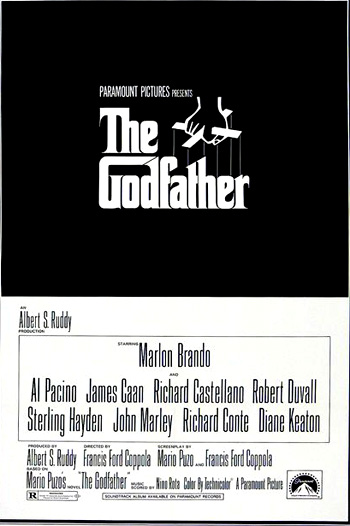
|

|
Enter the Dragon (1973, US/HK)
d. Robert Clouse, 102/99 minutes, Concord Productions Inc./Golden
Harvest Company/ Sequoia Productions/Warner Bros.
- This fast-paced kung-fu action-thriller from director
Robert Clouse, the big-budget version of the popular Chinese genre
of martial arts, starred Bruce Lee in his first (and last) English-language
(and Hollywood-produced) film. It was the first kung fu film produced
by a major Hollywood studio. It was taglined: "The first American
produced martial arts spectacular!"
- This legendary film is still considered the best "chopsocky" or "kickfest" (kung
fu and martial arts) film ever made by an American studio (Warner
Bros). It propelled Lee to major posthumous American
stardom shortly after his tragic and mysterious death in July 1973
at the age of 32 - it was Lee's biggest US success and last fully-completed
role.
- The popular, Hong Kong kung fu genre was catapulted
to world-wide prominence in the 1970s with all four of Bruce Lee's
martial-arts films, with spectacularly intense fight scenes.
Unfortunately, many of them were dubbed and had poorly-contrived
plots containing copy-cat James Bond elements.
- Bruce Lee's first two films
were Fists
of Fury (1971) and The Chinese Connection (1972).
Lee's two best films were his last - released post-humously
after he died at the young age of 32. His third film was The
Way of the Dragon (1972), billed as Enter the Dragon's
(1973) 'sequel' Return
of the Dragon (1974) when it was released in the US in 1974. It
was Lee's writing and directorial debut film, and the first
Hong Kong action movie ever to be shot in the West.
- The film featured two tremendous fight scenes: (1) competition
between Oharra and undercover agent Lee who displayed acrobatic fight
skills, flip kicks and lightning fast punches, (2) an equally great
fight scene (some in slo-mo) in an underground hall of mirrors between
martial arts master Lee and crime/drug lord Han, who wore serrated
knife blades in place of his detachable clawed iron hand.
|
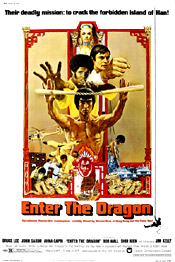
|
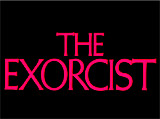
|
The Exorcist (1973)
d. William Friedkin, 122/132 minutes, Warner Bros./Hoya Productions
- The Exorcist was notable for being one of
the biggest box-office successes (and one of the first 'blockbusters'
in film history, predating Jaws (1975)),
and surpassing The Godfather (1972) as
the biggest money-maker of its time (it eventually grossed $193
million domestically). And it remains one of
the few horror films nominated for Best Picture.
- Warner Bros. had its first major hit with this sensational
and shocking film about
devil possession, an originally X-rated film that was released
as an uncut 'R' rating which allowed minors to view the film if
accompanied by an adult.
- The horror film masterpiece, the first major horror
blockbuster, was one of the most opposed and talked-about films,
especially during its pre-release time period. It became one of the most
opposed films for its controversial content.
- Friedkin adapted William Peter Blatty's best-selling, 1971 blockbuster
book about Satanic demon possession (based on a true-story of a 13
year-old Maryland boy in 1949), and created one of the most disturbing,
frightening, shocking, and exploitative films ever made. It was about
a young 12 year-old girl entering puberty and womanhood, who also
became possessed.
- The
landmark supernatural film encouraged the trend for big-budget
horror films, other cheaply-made imitations - and more blockbusters. It
was influential in creating knock-offs and a resurgence of films
featuring demonic possession and evil children (i.e., Sharon's
Baby (1975, UK), The
Omen (1976), etc.),
including its own series of sequels and prequels.
- Its controversial content included sensational,
nauseating, and horrendous special effects (360 degree head-rotations,
self-mutilation/masturbation with a crucifix, the projectile spewing
of green puke, a mixture of split-pea soup and oatmeal, etc.),
depictions of desecrations, vivid representations of evil,
and intense scenes of exorcism (accompanied by blasphemies,
obscenities and graphic physical shocks). One of the most controversial
scenes was the long sequence of invasive medical testing performed
on the hapless patient - criticized as medical pornography.
- The recognizable opening instrumental tune, titled
Tubular Bells (by Mike Oldfield), eventually became a #1 single
on the Billboard charts - and the first big seller for Virgin
Records.
- The film was enormously popular with moviegoers
at Christmas-time of 1973, but some portions of the viewing audience
fled from theaters due to nausea, convulsions, fainting or sheer
fright/anger (Headlines proclaimed: "The Exorcist nearly killed me!"),
and it was reported that one patron in San Francisco literally
attacked the screen in an attempt to kill the demon. Mass hysteria
led to paramedics being called to some theatres, and others were
picketed in protest.
- The film's showings also led to a reported increase
in temporary spiritual possessions or psychoses by individuals,
and an increase in requests for priests to exorcise everything
from loved ones and pets to houses, neighborhoods and appliances.
|
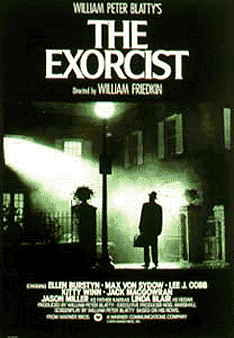
|
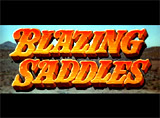
|
Blazing Saddles (1974)
d. Mel Brooks, 93 minutes, Crossbow Productions/Warner Bros.
- The iconoclastic, not-politically-correct comedy
was one of Mel Brooks' funniest, most successful and most popular
films, and his first commercial hit. It was an unsubtle spoof or
parody of all the cliches from the time-honored genre of westerns,
similar to the comic attitude of numerous Marx Brothers films.
It was the first in a series of satirizing parodies of classic
movie genres (often as star, scripter and director).
- The crude, racist, lewd, raunchy, dated and sexist
film with toilet humor and foul language included the main elements
of any western - a dance-hall girl, a gunslinger, a sheriff, a
town full of pure folk, and more, but it twisted them around. So
they became a black sheriff, a racist town, a sex-obsessed Governor,
and so forth. It told the story of the Waco Kid (Gene Wilder)
and Black Bart (Cleavon Little) - a black sheriff recruited to
clean up a white frontier town.
- The offensive, deliberately in-bad-taste film that
made fun of racism was nominated for three Academy Awards: Best
Film Editing, Best Song (music by John Morris with lyrics by Mel
Brooks), and Best Supporting Actress (Madeline Kahn) - without
any wins.
- Its most memorable scene, now considered tame when
compared to Dumb and Dumber (1994), was the bean-eating
scene of gaseous cowboys around the campfire.
- In the absurdist finale,
the action broke through the "fourth wall" into the WB
studios, onto a film set with Buddy Bizarre (Dom DeLuise) directing
a musical, then into the studio commissary for a pie fight, and
onto the streets of Burbank and the landmark Grauman Chinese Theatre
in Hollywood.
|
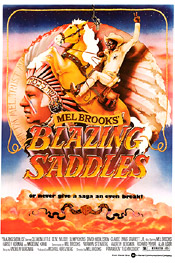
|
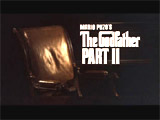
|
The Godfather, Part 2 (1974)
d. Francis Ford Coppola, 200/220 minutes, Paramount
Pictures/Coppola Company
- Best Director-winning Francis Ford Coppola's critically-acclaimed,
Best Picture-winning gangster epic sequel to The
Godfather (1972)
- considered the #1 gangster film of all time -- was actually a
prequel (and a continuation story). It marked one of those rare
instances in which the sequel was superior to the original film.
It was both critically-respected and commercially successful as
a grand and sweeping portrait of American gangsters.
- The three hour and twenty minute crime/gangster
film was
the second part of a planned Godfather Trilogy
that continued the saga of the Corleone Family, serving as both
a prologue and a sequel, extending over a period of 60 years and
three generations.
- The film was creatively structured with two narrative
lines, each at a different time and running parallel to each other.
One story line was the continuation of the previous film's story
line about successor godfather Michael Corleone (Al Pacino) and
the crumbling of his empire, and the other consisted of flashbacks
regarding the earlier history of the rise of Vito Corleone (Robert
DeNiro).
- It became the first 'sequel'
to win Best Picture (presented in 1975). It was the
winner of 6 Oscars: Best Picture, Best Director, Best Supporting
Actor (Robert DeNiro as the young Don Corleone), Best Adapted Screenplay,
Best Art Direction, and Best Score Oscars.
- It would help launch the
trend toward blockbuster sequels.
|
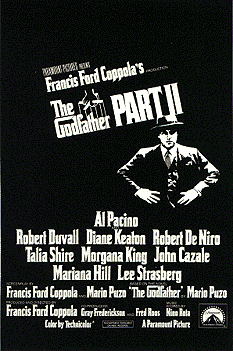
|
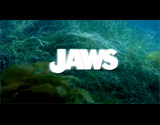
|
Jaws (1975)
d. Steven Spielberg, 124/130 minutes, Zanuck/Brown Productions, Universal
Pictures
- Director Spielberg's blockbuster giant Great White
Shark tale, a quintessential summer film and action/adventure/horror
classic, was derived from the best-selling novel by Peter Benchley. Steven
Spielberg's thriller was the first modern 'blockbuster' film to
top the $100 million record in box-office business in North America
(cruising past previous pace-setters Gone
With the Wind (1939), The
Sound of Music (1965) and The Godfather
(1972)). It earned its 27 year-old director (and Universal
Studios) a place in Hollywood by launching his career.
- In the story set in 1975, a popular Massachusetts
seaside resort area known as Amity Island (fictional) was gearing
up for the profitable summer tourist season beginning with the
July 4th Independence Day weekend. The new chief of police from
New York, Martin Brody (Roy Scheider), who was fearful of the water,
had been called upon to investigate a brutal shark attack upon
attractive blonde Chrissie Watkins (Susan Backlinie) in the film's
gripping opening. In truly frightening, scary and surprising attacks
on the New England coast, an unseen monstrous man-eater was preying
on the unsuspecting inhabitants and vacationers alike.
- Brody was confronted by the eager Mayor Larry Vaughn
(Murray Hamilton) and others to keep the town open. Three unlikely
partners teamed up on a suspenseful 'fishing trip' to hunt down
the rogue sea creature and destroy it: Chief of Police Brody, young
university-educated marine oceanographer Matt Hooper (Richard Dreyfuss),
and crusty, grizzled old-time fisherman Sam Quint (Robert Shaw)
resembling the obsessed Ahab in the Moby Dick tale. In
the climactic finale, the shark ended up pursuing Quint's boat,
the Orca,
and ultimately both Quint and the shark died bloody deaths and
the boat was destroyed. Brody and Hooper were forced to assemble
a makeshift raft and paddle back to Amity's shore.
- The killer shark film was memorable for its recognizable,
Hitchcock-like theme song/score by John Williams, massive tie-in
marketing, and its iconic poster. It was Williams' first famous
film score, that cleverly tied the approach of the shark to the
two-note instrumental theme. The production was troubled by a malfunctioning
mechanical shark named Bruce, and shooting ran 100 days over schedule
and was over-budget by double.
- The tagline for the tensely-paced film, "Don't
go in the water," kept a lot of shark-hysterical ocean-swimmers
and 1975 summer beachgoers wary and out of the ocean (similar to
the effect that Hitchcock's Psycho
(1960) had on shower-taking). "You're gonna need
a bigger boat" was one of its most memorable quotes.
- One of the unfortunate consequences of the film
was that it increased many negative stereotypes regarding sharks.
Both Peter Benchley and Steven Spielberg later bemoaned the fact
that the book and film hurt the shark population. The misguided
film made the Great White Shark the aggressive antagonist
(rather than humans), and helped to promote an increase in shark
hunting (known as "The Jaws Effect"). At the time, the
shark population markedly declined for awhile, and efforts at shark
protection and conservation suffered.
- Part of Jaws' financial
success was due to the fact that Hollywood preceded its summer release
by three nights of 30 second-TV ads during prime time on all the
networks - a massive TV marketing campaign costing $700,000. It
was also booked into 460 theatres for its opening weekend - a record!
- making it one of the first major films to open in a nationwide-release
throughout the country (another prominent film that also opened
in wide-release was the independent film Billy Jack (1971)).
- The first-ever summer nationwide release with commercials
was a new and revolutionary theory of movie marketing - a marketing
blitz - a new business model that has become the standard for studio
blockbusters. Eventually, the film earned box-office
of $266 million (domestic) and $476 million (worldwide) - the highest-grossing
movie in history at the time, on a budget of only $7 million.
- The film's tremendous success
spurred Hollywood studios to aggressively look for further modern
blockbusting, 'big-event' films that could break weekend box-office
records - fueled by increasingly more expensive ad campaigns, and
the film industry did so - with Star Wars
(1977), Grease (1978), and Superman
(1978), while overlooking or neglecting smaller films. There were other exploitative
imitators, knock-offs, copy-cats, and rip-off 'terror in the water'
films almost too numerous to mention.
- Three inferior sequels included: Jaws
2 (1978), Jaws 3 (1983), and Jaws: The Revenge (1987),
making it one of the earliest film franchises. Other films that rode
on Jaws' coat-tails included Mako: The Jaws of Death (1976), Tintorera...Bloody
Waters (1977), Orca (1977), Tentacles (1977), the Piranha films
(1978, 1981, and 2010), Killer Fish (1979), Crocodile
(1979), Anaconda (1997), the Peter Benchley-scripted NBC
mini-series The Beast (1999), Lake Placid (1999), the
effectively scary Deep Blue Sea (1999) [with a number of 'in-joke'
homages that paid honor to the original, as well as a memorable shark
chomping attack on Samuel L. Jackson], Open Water (2003), The Shallows
(2016), the Sharknado series
of TV movies (2013-2018), and The Meg (2018).
- On a lighter note, it also inspired spoofs and parodies,
including the opening of Airplane!
(1980) in which a jet's rear tail (like a shark fin) sliced
through the clouds, and an oft-played skit on Saturday Night
Live in which a shark disguised itself as a pizza and candy-gram
delivery person to enter an apartment. It was also parodied or
referenced in Top Secret! (1984), Clerks (1994), Swingers
(1996), and The Simpsons TV show - among others.
|
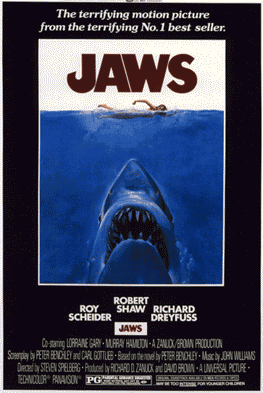
|

|
Nashville (1975)
d. Robert Altman, 159 minutes, ABC/Paramount Pictures
- Maverick director/producer Robert Altman's low-budget,
classic, multi-level, original, two and a half-hour epic study
of American culture, show-business, leadership and politics was
one of the great American films of the 1970s. In
the ensemble film, Altman was cynically commenting upon the confused
state of American society with its political emptiness and showy
commercialism. The business of country-western music co-existed
with the election campaign of an unseen, independent (populist)
party candidate. It
was a satirical film that commented upon religion, politics, sex,
violence, and the materialistic culture.
- The multi-faceted, beautifully-structured
film was an ensemble piece, a rich mosaic and a complex tapestry.
Altman's specialty was the multi-character mosaic narrative that
he had essentially invented and perfected. Nashville told
the free-form, explosive tragic-comedic tale of the inter-twined
(and colliding) lives of twenty-four protagonists during a five
day (long weekend) period in Nashville, Tennessee (the "Athens
of the South") - the capital of country music and a microcosmic
representation of all society.
- Colorful characters, both performers and audience
members in the mosaic-style film, converged in a massive traffic
jam and were present during a violent assassination scene by the
film's conclusion. Altman
keenly observed the differing agendas of the characters - companionship
and/or sex, a shot at stardom or political advancement, and musical
aspirations, to name a few. His trademark mosaic narrative style of
various stories interwoven and webbed together was also repeated
with The
Player (1992), Short Cuts (1993), and Gosford
Park (2001). This style influenced other films, such as Boogie
Nights (1997) and Paul Thomas Anderson's Magnolia (1999).
Other examples of multi-stranded parallel story-telling include
Traffic (2000), Crash (2005), and Babel (2006).
- The quirky film was shot in under 45 days, and
was the first major release that had actors performing live in
front of the camera during their song performances. The film received
a notorious rave "preview" review from critic Pauline
Kael (in The New Yorker) about four months before the
film was completed after she viewed a rough-cut ("I've never
before seen a movie I loved in quite this way"), and some
accused her of breaching professionalism by promoting the film
before its premiere in New York City.
- Hallmarks of Altman's aural and visual style were
evident everywhere - overlapping dialogue, life-like improvised
roles and ensemble acting, multiple means of communication to connect
the characters (phone calls, tape recordings, radio and TV, and
P.A. announcements), a continuously moving camera, long takes,
and imaginative sound and film editing.
- It was one of a number of films in the late 60s
and 70s that used country music as a backdrop, i.e., Bonnie
and Clyde (1967), Five Easy Pieces
(1970), and Frankenheimer's I Walk the Line (1970) with
five Johnny Cash tunes.
|
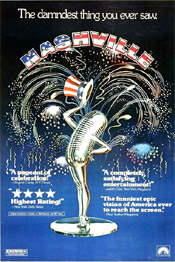
|
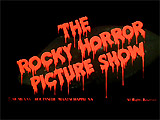
|
The Rocky Horror Picture Show (1975, US/UK)
d. Jim Sharman, 100/98 minutes, 20th Century Fox/Michael White Productions
- Perhaps the most popular cult film of all time,
this low-budget, campy horror rock musical from writer/director
Jim Sharman initially bombed at the box-office. After its
opening in London as a British musical stage play in June of 1973,
and in Los Angeles in March of 1974, The Rocky Horror Show opened
on Broadway in March of 1975. A film version of the original international
stage hit, Jim Sharman's and 20th Century Fox's The Rocky Horror
Picture Show (1975),
was released in Los Angeles in September of 1975, and was a commercial
failure. It was resurrected after a long run of midnight showings
at the Waverly Theater in Greenwich Village beginning on April
1, 1976. The Rocky Horror Picture Show holds the record for the longest
theatrical release in film history.
- Since then, it has achieved major cult film status,
and has been considered the longest-running 'midnight movie' of
all time. The film was revived as a multi-media, audience participatory
experience and
exploded as a worldwide phenomenon for many years.
- The strange tale was about a haunted house inhabited
by transexual aliens. It followed a straightlaced, wholesome, newly-engaged
couple, Brad Majors (Barry Bostwick in his feature film debut)
and Janet Weiss (Susan Sarandon) who were forced to take refuge
in a spooky mansion/castle on a rainy night when their car had
a flat tire. The two were brought into a world of subversiveness
by the bisexual host - the carnivorous "sweet transvestite
from Transsexual, Transylvania" Dr. Frank N. Furter (Tim Curry),
a mad scientist whose dream was to create the perfect man named
Rocky "with blond hair and a tan."
- There were many wild, energetic song-and-dance numbers
in this notorious midnight movie audience participation cult film,
including the opening song Science Fiction/Double Feature sung
by a giant pair of disembodied blood-red lips (voice of Richard
O'Brien) - a tribute to Hollywood's B-horror films. The film was
highlighted by lots of catchy, overtly-sexual songs-and-dances,
such as the famous Time
Warp ("It's just a jump to the left...") with unconventional
dancers of all races and sizes, and crazed transvestite Dr. Frank
N. Furter's campy introduction Sweet Transvestite.
- One of the longest-running films of all
time, the bizarre film honored (and gently spoofed) the horror B-movies
and science fiction genres of the past (RKO Pictures' King
Kong (1933),
Forbidden Planet (1956), The Wizard of Oz (1939), the Hercules films,
The Day of the Triffids (1963), the classic "atomic age" sci-fi
horror of the '50s, such as It Came From Outer Space (1953),
and, of course, Frankenstein (1931)).
- The film was
followed by a forgettable sequel, Shock Treatment (1981),
and a successful musical revival on Broadway in 2000 featuring Joan
Jett that ran for two years.
|

|

|
Annie Hall (1977)
d. Woody Allen, 93 minutes, Rollins-Joffe Productions/United Artists
- Writer/director auteur Woody Allen built his career
around his own persona - a quirky, nerdy anti-hero who was nonetheless
lovable. He started with an earlier series of five mostly silly,
light-hearted cultural spoofs including Take
the Money and Run (1969), Bananas
(1971), Everything
You Always Wanted to Know About Sex... (1972), and Love
and Death (1975), take-offs of
various film genres or books, often similar to the episodic Marx
Brothers' films. Then, he had his breakthrough film after shifting
to this semi-autobiographical, mature-themed, urban romantic comedy,
with its similar follow-up film
Manhattan (1979). It was his
most successful, deepest, self-reflexive, most elaborate and unified
work up to that time, and one of his biggest hits.
- The film's more sensitive and realistic (still-comical)
yet serious-minded tone about an intimate and emotional relationship
appealed to all film-goers, not just Woody Allen cultists. It was
the most representative film of neurotic New Yorker writer/director
Woody Allen. Allen would make a name for himself with many more modern
romantic comedies featuring struggles within relationships - the
precursor of many TV show rom-coms.
- The romantic comedy was a quintessential masterpiece
of priceless, witty and quotable one-liners within a matured, focused
and thoughtful film. It was a bittersweet romantic comedy of modern
contemporary love and urban relationships (a great successor to
classic Hollywood films such as The Awful
Truth (1937) and The
Philadelphia Story (1940)).
- The acclaimed romantic comedy
with a stream of consciousness story about an unstable love affair,
a marked departure from Allen's earlier slapstick-filled pictures,
won the Best Picture honors over the special-effects, science-fiction
blockbuster Star
Wars (1977), and gave the director/star/writer two
Oscars (Best Original Screenplay and Best Director). Woody Allen became
the first director
to win an Academy Award for a film he starred in. This was a rare feat
for a comedy. From its five nominations, it lost only Allen's
own Best Actor nomination.
- The film influenced fashion designers (with the
masculine, androgynous "Annie Hall" look) and made Best
Actress-winning Diane Keaton a new leading lady. The costuming
of the title character -- dubbed
the 'Annie Hall' look -- created a fashion craze.
|
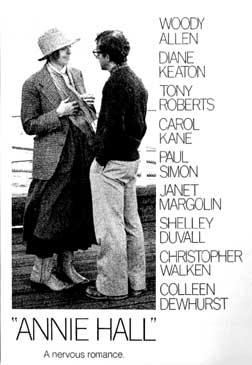
|

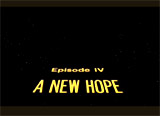
|
Star Wars (1977) (aka
Episode IV: A New Hope)
d. George Lucas, 121/125 minutes, LucasFilm/20th Century Fox
- George Lucas' space opera, made for $11 million,
was released in theaters in mid-summer and grossed nearly $200
million on its first release, topping Jaws
(1975) as
the highest earning film to date. After adjusting for inflation,
its US gross profit was second only to Gone
with the Wind (1939). Until Jaws
(1975) and
then Star Wars (1977), the
summer was typically Hollywood's slow season -- not true afterwards.
- Star Wars (1977) was
nominated for ten Academy Awards (including Best Picture), and
won in six (mostly technical) categories. It marked the first use
of an animated 3-D wire-frame graphic, and extensively used CGI.
It ultimately helped to resurrect
the financial viability of the science-fiction genre, a category
of films that was considered frivolous and unprofitable. The
typical sci-fi film was no longer a cheap serial (Flash Gordon),
monster movie, or kids TV show.
- Its exhilarating, action-paced computer-generated
effects thrilled audiences. Many of the big-budget
film's awe-inspiring and innovative special effects were produced
at Lucas' ground-breaking, respected visual effects company ILM
(Industrial Light & Magic)
founded in 1975 - a leader in computer graphics (CGI). (Note: ILM
was the original founder company of the animation studio Pixar.)
The film was influential to a new generation of film-makers, including
John Lasseter, James Cameron and many others. [It
led to the first all CGI character in the
form of Jar Jar Binks - an offshoot in Star Wars Episode I:
The Phantom Menace (1999).]
- The phenomenal epic space opera generated
a remarkable two sequels (for the original trilogy) and three prequels
(in a second trilogy), and led to the equally-successful collaboration
between Spielberg and Lucas for Raiders
of the Lost Ark (1981). It created
a massive dedicated fan-base for the first film - and all films
following.
- It became one of the strongest cultural influences
of recent times, converting an action-adventure film into a major,
blockbusting marketing franchise. The astoundingly lucrative merchandising
campaign associated with the film was truly revolutionary. It encouraged
an entire marketing industry of Star
Wars-related, tie-in
items (i.e., toys, video games, novels, comics, TV series, novelty
items at fast food restaurants, even video games, etc.).
- In a new
approach to Hollywood film-making and merchandising, Lucas had
wisely accepted only $175,000 as his writer's/director's fee in
return for the much more lucrative forty percent of merchandising
rights for his Star Wars Corporation. As
a result, the merchandising rights have now become a major part
of contract negotiations by the studios.
- Its story, themes, and tone were based upon Saturday
afternoon matinees, serials, and comic strips, usually with cliff-hanging
endings. It
borrowed from many strands of cinema-arts: Buck Rogers and Flash
Gordon comic book serials, previous sci-fi films, tales
of medieval knights, the James Bond films, sorcerer and magic
stories, samurai films (The
Hidden Fortress (1958, Jp.)),
westerns, swashbucklers, WWII action dogfight sequences, cliffhangers,
hero tales, etc. It also featured two comical robotic droids
that became justly famous and often imitated. It also
popularized the phrase "May
the Force be with you" into
common usage.
- The film was also awarded with
a Special Achievement Award for Sound Effects for the creation
of the alien, creature, and robot voices (Benjamin Burtt, Jr.), and
it was the first feature film to be screened in Dolby Stereo.
- One of its negative influences was that it accelerated
a trend towards special-effects-laden blockbuster films targeted
at young people. This appealing film was criticized
for encouraging a boom in spectacular (but sometimes drab) special-effects
laden blockbusters (with thin plot lines) for decades after.
|
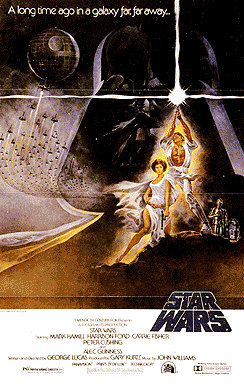
|
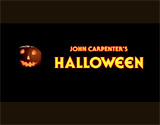
|
Halloween (1978)
d. John Carpenter, 91/101 minutes, Compass International
Pictures/Falcon International Productions
- John Carpenter's low-budget (filmed in about 20
days), exploitative film officially began the teen slasher film
cycle (and invented many of its film cliches), although it was
dismissed at the time as schlock by most critics, until championed
by the Village Voice and the 'Ebert & Siskel'
Sneak Previews PBS-TV review show as a work of art.
- A genuinely scary, stylistic and tasteful, extremely
well-crafted slasher/horror classic that influenced the film industry
both thematically and artistically. Its main killer-protagonist
was a faceless, masked murderer, portrayed as an evil incarnate
bogeyman. However, it was NOT the first slasher movie - it was
preceded by Black
Christmas (1974) and The Texas Chain Saw Massacre (1974) and
a few others.
- Halloween grossed about $55 million (worldwide),
and was a surprise hit - it was one of the most successful independent
films ever made. Its influence could be seen in the Friday
the 13th series, in the Nightmare
on Elm Street series, in the Hellraiser films, and in
the Scream entries in the genre.
- Throughout the manipulative, morbid film, the suspenseful
stalkings and killings were seen from the subjective vantage point
of the killer's or 'peeping tom's' eyes, a few times while looking
through his mask. This technique literally placed
audiences behind the cold and calm killer's mask - and almost
inside his head, implicating them in the bloodlusting killings
(and strangulations).
- Almost every scene was filmed with a constantly-moving
camera (the Steadicam variety) to make the audience feel disordered,
totally insecure, unsettled and paranoid, believing that every
ominous corner, shadow, noise, or space was potentially life-threatening
or dangerous and that everyone was a helpless victim of random
violence.
- Its main heroine character was portrayed by Jamie Lee Curtis, the
daughter of Tony Curtis and Janet Leigh (who had starred in one of
the landmark horror films of all time, Psycho (1960)), who was following
in their footsteps.
- The film set in motion the Puritanical, psycho-pathological
principle that one's survival was directly proportional to one's
sexual experience. It created the crude cliche that death followed
or accompanied sex (as a way to sensationalize and publicize the
nudity and sex-related violence). It also asserted the allegorical
idea that sexual awakening often meant the literal 'death' of innocence
(or oneself). This thematic assertion was carried through into
the Friday the 13th series, adding the "virginal final girl"
component.
- Halloween spawned numerous, often routine, imitative
and mediocre sequels (seven sequels and remakes in 2007 and 2009),
and ushered in a glut of other similarly gory, low-budget films
(such as Prom
Night (1980)) that perverted this horror/slasher genre.
|
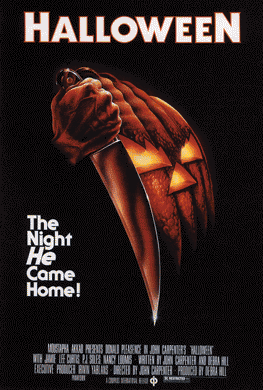
|
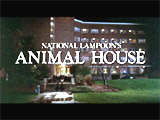
|
(National Lampoon's) Animal House (1978)
d. John Landis, 109 minutes, Universal Pictures/Oregon Film Factory, Stage
III Productions
- John Landis' wildly-successful, R-rated, gross-out
frat-boy teen comedy featured unrefined humor. The low budget,
coming-of-age film (at $2.5 million) was about an anarchic, renegade,
party-animal Delta House at fictitious Faber College (it was filmed
on the campus of the University of Oregon over a period of almost
5 weeks), in conflict with the WASP-ish Omega House, and the college's
establishment figure Dean Wormer (John Vernon).
- Landis was tapped as director - known for his controversial
independent production of Kentucky Fried Movie (1977),
a series of short, irreverent and tasteless sketches woven together.
- It was
the first $100 million hit comedy, the highest-grossing film comedy
at the time, and the 7th highest-grossing film of the 1970s. When
adjusted for inflation, it stands as the 58th highest-grossing
film of all time. Most traditional comedies at the time wouldn't
deal so openly with sex, generational politics, or race.
- The low-brow guy movie was one of the earliest
films to be targeted directly at the teenaged audience - and set
the stage for further Hollywood films made just for that demographic.
It ushered in a growing era of gross-out teen comedy. It is still
memorialized for its dozen classic catch phrases and quotes, and
memorable film sequences, such as Larry's "Angel vs. Devil"
dialogue scene regarding his passed out date (Sarah Holcomb),
and John Blutarsky (Bluto)'s 'Peeping Tom' scene outside a window
viewing scantily-clad sorority girls.
- Fraternity "toga parties" re-emerged as
a fad at colleges across America following the release of this
film. The film substantially distorted the image of what the college-going
experience was like. Annual college spring breaks, dedicated to
partying, heavy drinking and carousing, also took off in high-gear
after the film's release.
- It featured a new
generation of stars, including John Belushi as slobbish Bluto,
a Saturday Night Live comic at the time. He became a major
male comedy film star - until his career was cut short by a drug
overdose in 1982. He was the precursor of
other SNL comics who followed in films (i.e., Dan Aykroyd, Chevy Chase, Bill Murray,
Michael Myers, Will Ferrell, Tina Fey, etc.). Prior to Saturday
Night Live's 1975 debut, the only two TV shows
that managed to capture the youth market were American Bandstand and The
Monkees.
- It set off a trend toward more feature films with
the same subversive, crude, sexy hi-jinks, including the Porky's films
(1982-1985), the Revenge
of the Nerds (1984-1987), and the Police Academy series
(1984-1989) - even the American Pie series (1999-2012), Old
School (2003),
and The
Hangover films (2009-2013)
owe a debt to Animal House.
- Major principals responsible for the film, producer
Ivan Reitman, screenwriter Harold Ramis and director Landis went
on to produce, direct and script films such as Caddyshack (1980),
The Blues Brothers (1980), Stripes (1981),
(National Lampoon's) Vacation (1983), Trading Places (1983), Ghostbusters
(1984), Back
to School (1986), Club Paradise (1986), and Groundhog Day
(1993).
|
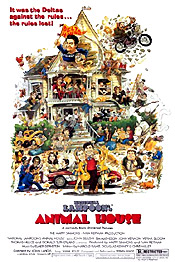
|

|
Superman: The Movie
(1978, UK/US) (aka Superman)
d. Richard Donner, 143/127 minutes, Warner Bros./Dovemead
Films/Film Export A.G.
- Director Richard Donner's first big blockbuster
comic book adaptation movie was a major A-level Hollywood
feature hit, grossing over $300 million (with a mega-budget of
$55 million). It was a major production: from its casting (with
prominent actors in supporting roles), to its soaring music,
visual effects (making Superman fly realistically), and its record
length end-titles (7 minutes).
- Its production occurred at the same time as Lucas'
Star Wars (1977) and
Spielberg's Close
Encounters of the Third Kind (1977) - all films were credited
with creating a new surging interest in sci-fi films.
- The film proved that Superman was more than a Saturday
matinee serial or popular TV show. This was the first of four
epic, superhero franchise films featuring comic-book hero Superman
derived from the 1938 Action Comics character - not counting the
latest film remakes. It was followed by three sequels - Superman
II (1980), Superman III (1983) and Superman IV: The Quest
for Peace (1987).
- Other comic book superhero franchises that later
emerged owed their popularity to this film: the
Batman series,
the X-Men series,
and the Spider-Man movies.
- Marlon Brando broke the $3 million mark for an actor's
earnings, when he was reportedly paid a salary of $3.7 million
and over 11 percent of the gross (his total earnings were $14 million)
for his 10-minute cameo appearance (shot over 12 days) as Jor-El,
the title character's father.
He also received top-billing (with Gene Hackman) over Christopher
Reeve.
- Christopher Reeve was paid a salary of $250,000,
plus $25,000 a week -- it was one of the highest salaries paid
to an unknown actor for a major feature film. He was selected from
over 200 actors who tried out for the role.
- It was nominated for three Academy Awards (Best
Film Editing, Best Sound Mixing, and Best Original Score by John
Williams), and received a Special Achievement Academy
Award for its Visual Effects.
- It proved to be a major influence
on this kind of film in the future, with its origin story, the
fact that the first two films were shot back to back, and that
the major superhero character had a dual personality. Director
Richard Donner filmed both Superman
(1978) and Superman II (1980) simultaneously, when
Richard Lester was called upon to replace Donner and finish the
second film.
|
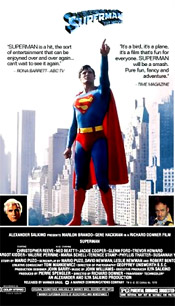
|
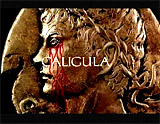
|
Caligula (1979, It./US)
d. Tinto Brass, 156/148/102 minutes, Penthouse
Films Int'l/Felix Cinematografica
- This lavish Roman-Empire epic (and biopic) was the
last major attempt of its era to include graphic sexual content
in a mainstream film. It was written by Gore Vidal and co-financed
by adult-oriented
Penthouse magazine's producer Bob Guccione (the magazine's
sole feature film) as a tie-in to his publishing empire. It suffered
a seriously-troubled production - the script underwent several
re-writes after the director and cast found Gore Vidal's interpretation
unsatisfactory (Vidal later disowned it and removed his name).
- The
film's director Tinto Brass had only one major film in his resume, Salon
Kitty (1976) about
a German brothel used by the Nazis. Brass also disavowed the film
when the producers added unsimulated hard-core sexual content (some
with Penthouse Pets) without his knowledge.
- The audacious film advertised itself as "the
most controversial film of the 20th century" -
and was the most expensive pornographic film ever made. It provoked
headlines for its graphic sexual content, when released in the
US in 1980. Fearing an X rating, it was originally self-rated as
MA (mature audiences only) and shown in a 156-minute
version, then it was severely edited for an R-rating down
to about 102 minutes, and also re-released in an 148-minute version.
- This was Hollywood's first big-budget ($17.5 million
that later ballooned to $22 million), bizarre blockbuster sexploitation
epic of 'classy' hardcore sex and gory violence - and it became
both a critical and commercial disaster after a very limited theatrical
release (due to fear of prosecution for obscenity). Caligula grossed
$23 million at the box office, and was noted as the highest-grossing
pornographic film ever produced independently.
- It was the first major motion picture that juxtaposed
segments featuring respected, mainstream actors with scenes that
were essentially pornographic. The objectionable film was originally
intended to be high-art (although it turned out to be excessive
cinematic sleaze), with major and notable stars (Malcolm McDowell
as the infamous, crazed and corrupt Roman emperor, John Gielgud,
Helen Mirren, Peter O'Toole), but was described as a "moral
holocaust" by
Variety and reviewers considered it worthless fantasy trash.
- This depraved movie, condemned as worthless fantasy
trash, arrived just before the new conservatism that took place
during the Reagan presidential administration and its subsequent
Meese Commission Study of Pornography (finally published in mid-1986).
It remains banned in some countries.
- Hollywood's recent attempts to sensationalize antiquity,
which owe some debt to Caligula, have found their way into
feature films (such as Gladiator (2000), Troy (2004), Alexander
(2004), and 300 (2007), and cable TV shows (such as
Rome (2005-2007), Game
of Thrones (2011-9), and Spartacus (2010-2013)).
|
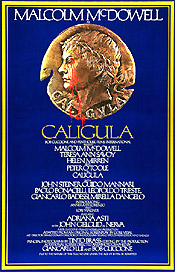
|
